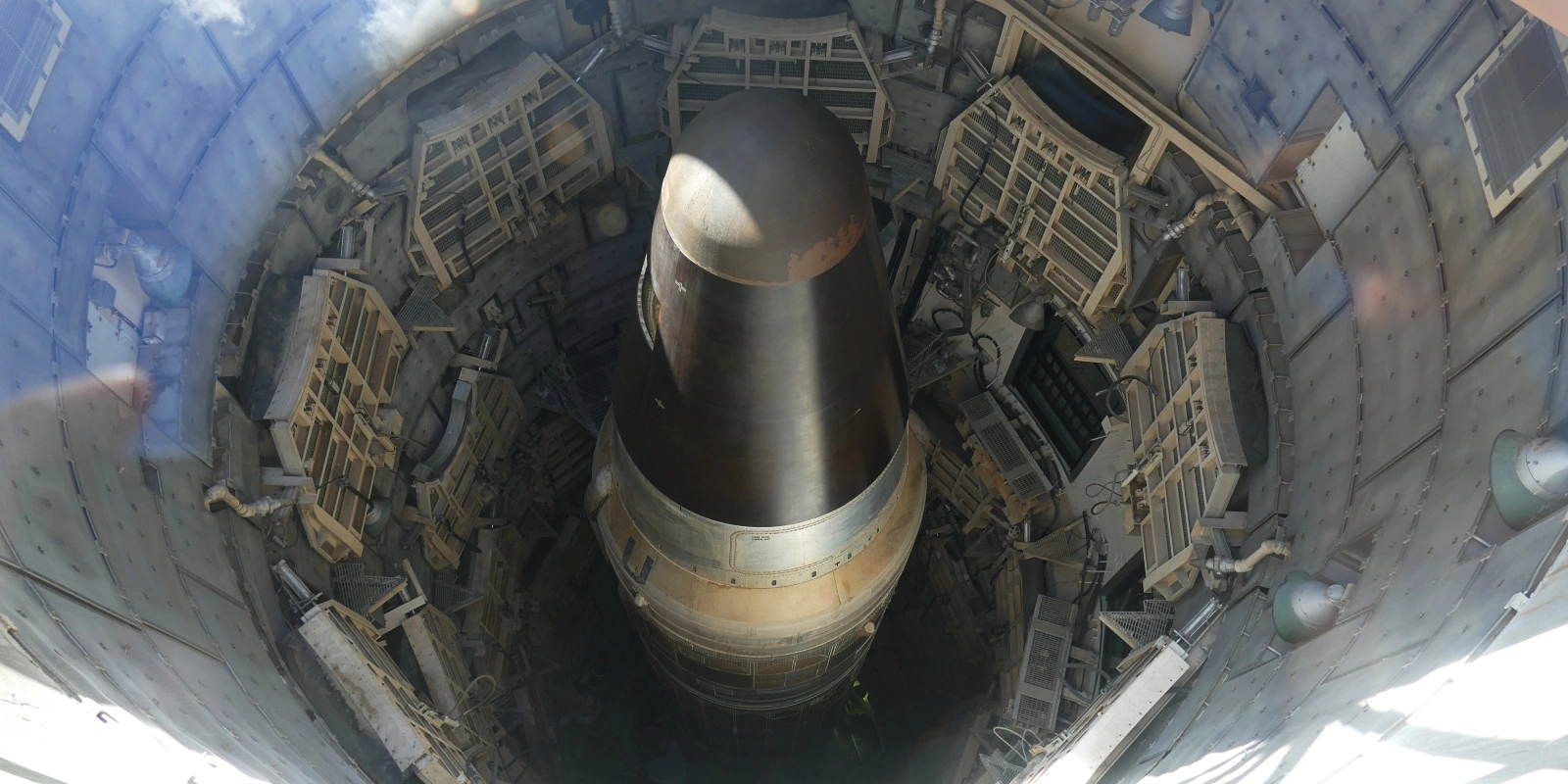
The Pentagon is currently planning to replace its current arsenal of intercontinental ballistic missiles (ICBMs) with a brand-new missile force, known as the Ground-Based Strategic Deterrent, or GBSD.
The GBSD program consists of a like-for-like replacement of all 400 Minuteman III missiles that are currently deployed across Colorado, Montana, Nebraska, North Dakota, and Wyoming, and will also include a full set of test-launch missiles, as well as upgrades to the launch facilities, launch control centers, and other supporting infrastructure. The GBSD program will keep ICBMs in the United States’ nuclear arsenal until 2075, and is estimated to cost approximately $100 billion (in Then Year dollars) in acquisition fees and $264 billion (in Then Year dollars) throughout its life-cycle.
However, critics of the GBSD program––which include a chorus of former military commanders and Secretaries of Defense, top civilian officials, current congressional committee chairs, subject matter experts, and grassroots groups––are noting a growing number of concerns over the program’s increasing costs, tight schedule, and lack of 21st century national security relevance. Many argue that the GBSD’s price tag is too high amid a plethora of other budgetary pressures. Many also say that alternative deterrence options are available at a much lower cost, such as life-extending the current Minuteman III ICBM force.
Despite these concerns, the GBSD program has been accelerated in recent years, apparently in an effort to lock in the system before the arrival of a new administration. However, the Pentagon has not offered a convincing articulation of what role these Cold War-era weapons are supposed to play in a post-Cold War security environment. Attempts in Congress to scrutinize the program have been shot down, usually with the lobbying help of the major GBSD contractors.
As a result, key decisions during the most crucial years of GBSD have been made without being able to access the full scope of information and analysis about the program.
To that end––and with generous support from Ploughshares Fund––the Federation of American Scientists has initiated an external review of the GBSD program, in addition to reviewing the fundamental role of ICBMs in US nuclear strategy. This project aims to put together a comprehensive, unclassified picture of the GBSD, while challenging many assumptions about the history, purpose, and utility of ICBMs. We hope it will be a useful resource for Congress, the incoming Biden administration, and the public.
Polling
On behalf of the Federation of American Scientists, ReThink Media conducted a national survey of 800 registered voters between 12-28 October 2020, with the purpose of exploring Americans’ opinions about US nuclear posture in general, and intercontinental ballistic missiles (ICBMs) in particular. The survey included a 200 oversample of registered voters in “nuclear sponge” states (Colorado, Montana, North Dakota, Nebraska, and Wyoming), in order to gain deeper insight into how residents of the “nuclear sponge” think about the weapons that their states are hosting.
To the authors’ knowledge, this is one of the most in-depth US-based surveys ever conducted about ICBMs, and therefore, the results shed significant light on how Americans perceive ICBMs and their role in US nuclear doctrine, and whether they ultimately support continued investment in this particular weapon system in the form of the Ground-Based Strategic Deterrent (GBSD).
Our polling results are available in the report Public Perspectives on the US Intercontinental Ballistic Missile Force, here.
Op-eds
4/20/21: Forbes, “Biden Could Win Back Progressives By Pausing A Controversial New Nuclear Weapon”
12/10/20: Defense One, “ICBM Advocates Say US Missile Subs Are Vulnerable. It Isn’t True”
11/3/20: Federation of American Scientists, “Environmental Assessment Reveals New Details About the Air Force’s ICBM Replacement Plan”
10/28/20: Bulletin of the Atomic Scientists, “Nuclear disarmers can’t forget the communities that rely on military spending”
9/10/20: Forbes, “Trump Is A Hypocrite, But He’s Right About The Military-Industrial Complex”
8/12/20: Forbes, “Democrats And Republicans Agree: Phase Out Land-Based Nuclear Missiles”
6/30/20: Forbes, “Democrats May Fund Trump’s Nuclear Modernization Plan Without A Fight”
6/22/20: Forbes, “The Trump Administration Is Using The Pandemic To Ignite The Arms Race”
4/21/20: Forbes, “Congress Should Hit Pause On The New Intercontinental Ballistic Missile”
3/16/20: Forbes, “The U.S. Nuclear Deterrent Is Not Prepared For Climate Catastrophe”
In the news
7/28/21: Daily Montanan, “New report questions the necessity of ICBM silos in Montana, Wyoming and North Dakota”
6/29/21: Business Insider, “Democrats take aim at the US’s new $264 billion ICBM amid search for cash to boost the military”
5/19/21: Billings Gazette, “Tester discusses defense priorities ahead of Biden budget request”
4/2/21: The National Interest, “Does America Need New ICBMs (Or Any at All)?”
3/30/21: Press The Button Podcast, “The Inherent Danger of ICBMs”
3/22/21: Der Spiegel, “Darum bauen die USA neue Atomwaffen”
3/17/21: Democracy Now!, “U.K. Lifts Cap on Nuclear Arsenal as U.S. Considers Plan for $100 Billion “Cold War-Era” Missile”
3/14/21: Omaha World-Herald, “Russia, China could pose nuclear threat if arsenal isn’t rebuilt, StratCom chief says”
3/10/21: The Daily Beast, “Scientists Are Worried About U.S. Plan to Build an ‘Outdated’ $100B Nuclear Weapon: Report”
3/10/21: Common Dreams, “New Report to Expose War Industry Lobby Behind $264 Billion US Nuclear Missile ‘Boondoggle’”
3/10/21: The Guardian, “‘Cold war-era weapon’: $100bn US plan to to build new nuclear missile sparks concern”
3/4/21: Project on Government Oversight, “Joe Biden’s Nuclear Triad”
2/22/21: Bloomberg, “The U.S. Doesn’t Need New Missiles in the Ground”
2/11/21: Politico, “Air Force prepares for budget battle over nuclear weapons”
2/9/21: Press The Button Podcast, “Civil Rights and Nuclear Disarmament (Early Warning)”
2/8/21: Bulletin of the Atomic Scientists, “Why is America getting a new $100 billion nuclear weapon?”
2/5/21: The Drive, “Majority Of Voters Don’t Want Billions Spent On New ICBMs To Overhaul America’s ‘Nuclear Sponge’”
2/5/21: Defense News, “Majority of voters support ICBM replacement alternatives, new poll finds”
11/7/20: Bullet Points Podcast, “Matt Korda and the Future of Nuclear Weapons”
10/7/20: Cape Breton Spectator, “No Escape from the Military Maze?”
9/27/20: Omaha World-Herald, “New generation of ICBMs means Nebraska will continue to be ‘nuclear sponge,’ warn nuke skeptics”
Open Source Data Collection,
Global Nuclear Weapons Arsenals,
Missile Defence,
Nuclear-Climate Nexus
This project is made possible by generous contributions from Ploughshares Fund, with general support from the John D. and Catherine T. MacArthur Foundation. Special thanks to our friends at ReThink Media for working with us on our polling effort, and for providing their expertise in publicizing and communicating our findings to a wide range of audiences. The statements made and views expressed are solely the responsibility of the authors.

The Nuclear Information Project provides the public with reliable information about the status and trends of the nuclear weapons arsenals of the world’s nuclear-armed countries.
Reports
Siloed Thinking: A Closer Look at the Ground-Based Strategic Deterrent (Mar. 2021)
This report reviews the fundamental role of ICBMs in US nuclear strategy and examines the Pentagon’s justifications for pursuing an ICBM replacement program.
The report ultimately suggests that these justifications were based on flawed assumptions, and many have since been deprioritized. The report also suggests that the initial outcome favoring a brand-new ICBM replacement program was largely predetermined by arbitrary force requirements and timelines that have little 21st century strategic rationale.
Download the report here.
Alternatives to the Ground-Based Strategic Deterrent (Feb. 2021)
This policy memo suggests that the Biden administration should immediately launch a National Security Council-led strategic review examining the role of ICBMs in US nuclear strategy, and presents four alternative policy options that the Biden administration could pursue in lieu of the current GBSD program of record.
Download the report here.
Public Perspectives on the US Intercontinental Ballistic Missile Force (Jan. 2021)
This report features the results of an October 2020 poll on US nuclear policy conducted by ReThink Media on behalf of the Federation of American Scientists.
Download the report here.
Polling
On behalf of the Federation of American Scientists, ReThink Media conducted a national survey of 800 registered voters between 12-28 October 2020, with the purpose of exploring Americans’ opinions about US nuclear posture in general, and intercontinental ballistic missiles (ICBMs) in particular. The survey included a 200 oversample of registered voters in “nuclear sponge” states (Colorado, Montana, North Dakota, Nebraska, and Wyoming), in order to gain deeper insight into how residents of the “nuclear sponge” think about the weapons that their states are hosting.
To the authors’ knowledge, this is one of the most in-depth US-based surveys ever conducted about ICBMs, and therefore, the results shed significant light on how Americans perceive ICBMs and their role in US nuclear doctrine, and whether they ultimately support continued investment in this particular weapon system in the form of the Ground-Based Strategic Deterrent (GBSD).
Our polling results are available on the FAS website here, and our report, Public Perspectives on the US Intercontinental Ballistic Missile Force, is available in PDF form here.

